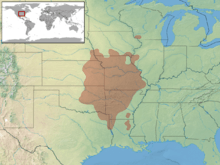Carphophis vermis
Carphophis vermis (common name western worm snake[5]) is a species of small, nonvenomous colubrid snake native to the United States.
- For the western worm snake from Namibia and South Africa, see Namibiana occidentalis
| Western worm snake | |
|---|---|
| Carphophis vermis in Arkansas, USA | |
| Scientific classification | |
| Kingdom: | Animalia |
| Phylum: | Chordata |
| Class: | Reptilia |
| Order: | Squamata |
| Suborder: | Serpentes |
| Family: | Colubridae |
| Genus: | Carphophis |
| Species: | C. vermis |
| Binomial name | |
| Carphophis vermis (Kennicott, 1859) | |
 | |
| Synonyms | |
Etymology
The specific name, vermis, is Latin for "worm".[6]
Physical description
Western worm snakes have a dark, black or purplish dorsal coloration, with a lighter, pink or reddish underside.[7]
Adults are usually from 19–28 cm (7.5–11 in) in total length; however, the maximum recorded total length is 37.5 cm (14.8 in).[8]
Geographic range
Western worm snakes are found in the United States in southern Iowa, southeastern Nebraska, eastern Kansas, western Illinois, Missouri, Louisiana, eastern Oklahoma, and northeastern Texas with isolated records from southwestern Wisconsin, southeastern Arkansas and middle Tennessee.[4]
Behavior
Worm snakes are fossorial, and spend the vast majority of time buried in loose, rocky soil, or under damp forest leaf litter. They are abundant within their range, but rarely seen due to their secretive nature.[9]
Reproduction
Little is known about their mating habits, but breeding likely occurs in the early spring. Eggs are laid in the early summer. Clutch size is normally 1-8 eggs, and hatching takes place in August or September. Hatchlings range in size from 3 to 4 inches (7.6 to 10.2 cm) in total length.
Diet
The worm snake's diet consists almost entirely of earthworms,[9] but it will also consume soft-bodied insects.
Defense
If harassed, it will often release foul smelling musk from its cloaca. If handled, it may press its tail tip into the captor's hand as a defense mechanism.
References
- Stejneger, L., and T. Barbour. 1917. A Check List of North American Amphibians and Reptiles. Harvard University Press. Cambridge, Massachusetts. 125 pp. (Carphophis vermis, p. 74.)
- Conant, R., and W. Bridges. 1939. What Snake Is That? A Field Guide to the Snakes of the United States East of the Rocky Mountains. (with 108 drawings by E. Malnate) D. Appleton-Century. New York and London. Frontispiece map + viii + 163 pp. + Plates A-C, 1-32. (Carphophis amoena vermis, p. 32 + Plate 2, Figure 5.)
- Wright, A.H., and A.A. Wright. 1957. Handbook of Snakes of the United States and Canada. Comstock. Ithaca and London. 1,105 pp. (in two volumes) (Carphophis amoenus vermis, pp. 110-112, Figure 35 + Map 12 on p. 105.)
- The Reptile Database. www.reptile-database.org.
- http://www.zo.utexas.edu/research/txherps/snakes/carphophis.vermis.html
- Mish, F.C., Editor in Chief. 2004. Merriam-Webster's Collegiate® Dictionary, Eleventh Edition. Merriam Webster. Springfield Massachusetts. 40a + 1,623 pp. ISBN 0-87779-809-5. ("worm", p. 1444.)
- Smith, H.M., and E.D. Brodie, Jr. Reptiles of North America: A Guide to Field Identification. Golden Press. New York. 240 pp. ISBN 0-307-13666-3. (Carphophis amoenus vermis, pp. 162-163.)
- Conant, R. 1975. A Field Guide to Reptiles and Amphibians of Eastern and Central North America, Second Edition. Houghton Mifflin. Boston. xviii + 429 pp. ISBN 0-395-19979-4 (hardcover), ISBN 0-395-19977-8 (paperback). (Carphophis amoenus vermis, p. 175 + Plate 25 + Map 131.)
- Schmidt, K.P., and D.D. Davis. 1941. Field Book of Snakes of the United States and Canada. G.P. Putnam's Sons. New York. 365 pp. (Carphophis amoena vermis, pp. 102-104, Figure 20.)
Further reading
- Behler, J.L., and F.W. King. 1979. The Audubon Society Field Guide to North American Reptiles and Amphibians. Knopf. New York. 743 pp. ISBN 0-394-50824-6. (Carphophis amoenus vermis, p. 592 + Plate 493.)
- Kennicott, R. 1859. Notes on Coluber calligaster of Say, and a description of new species of Serpents in the collection of the North Western University of Evanston, Ill[inois]. Proc. Acad. Nat. Sci. Philadelphia [11]: 98–100. (Celuta vermis, pp. 99–100.)
External links
| Wikispecies has information related to Carphophis vermis |
| Wikimedia Commons has media related to Carphophis vermis. |
- Species Carphophis vermis at The Reptile Database
- "Carphophis vermis" at the Encyclopedia of Life

- Western Worm Snake, Reptiles and Amphibians of Iowa
